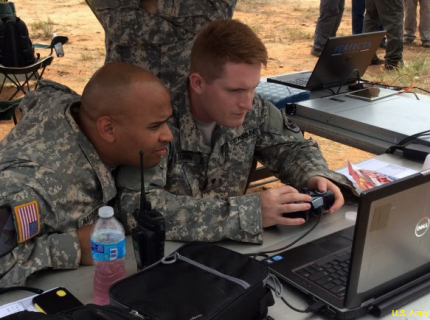Army, partners work toward better battlefield intelligence collection
The annual Enterprise Challenge tests intelligence technologies in real-world scenarios for the Army, other DOD agencies, contractors and coalition forces.

Soldiers check the full-motion video provided by a surveillance aerostat.
In an important annual exercise, the Army recently put the architectures and technologies for battlefield intelligence gathering to the test, working with other Defense Department agencies, contractors and coalition partners at Fort Huachuca, Ariz., as part of the Enterprise Challenge, or EC-15.
Hosted by the Army Intelligence Center of Excellence, EC-15 focused on how soldiers in the field collect intelligence for tactical advantages while working on other enterprise objectives, including sensor interoperability, international partners’ interoperability, advancing DOD’s cloud computing strategy, supporting the Defense Intelligence Information Enterprise and conducting enterprise interoperability assessments of the Distributed Common Ground System-Army (DCGS-A), according to an Army release.
“Events like EC-15 allow us to develop, test and demonstrate systems that are intuitive for our younger soldiers who grew up in the era of video games and smartphones,” said Dr. Paul Zablocky, Intelligence and Information Warfare Directorate (I2WD) director for the Communications-Electronics Research, Development and Engineering Center. “They expect that ease of use and systems that are capable of handling more than one application at a time.”
CERDEC, the Army’s lead for intelligence system research and development, often takes part in these types of exercises and assessments.
During the exercises, which took place throughout July, both civilian and military personnel recreated scenarios that might occur in an area of operation, so that personnel could test and work under real-world conditions.
“With these systems, we can train soldiers as if they were at war, but there aren't any of the threats associated with war,” said Tom Somers, I2WD TROJAN branch chief. “Training the tactics, techniques and procedures greatly reduces their learning on the fly.”
Another scenario involved the use of aerostat platforms to provide video surveillance to be reported to teammates on patrol.
"In particular to this type of system, I think the biggest thing is simplicity. They want to use MI [Military Intelligence] soldiers, but realistically when this gets pushed out to the force, it could come down to anybody, any soldier,” said Sgt. 1st Class Ian Watterson of the 111th MI Brigade under 305th MI Battalion. “They wanted to have it as a simple as possible, easy to pick up. The controller is something you can find with computer games. Anyone can really pick it up, kind of play with it and use it effectively."
CERDEC’s I2WD command and control trailer, which was brought to support the exercise, “reduces the time it takes to troubleshoot, it is more repeatable than a set-up in the field, helps with lessons learned, and better allows soldiers to train on the systems before being sent to hostile environments,” Somers said.




